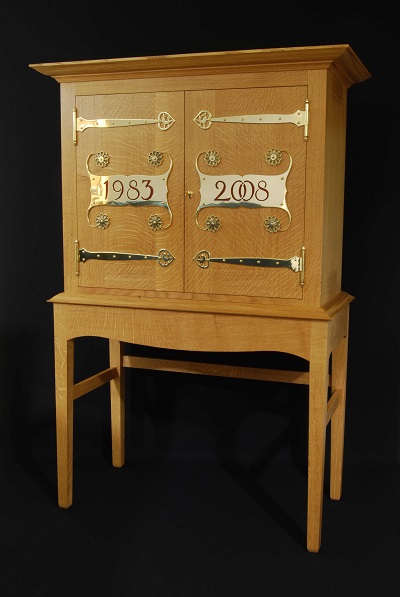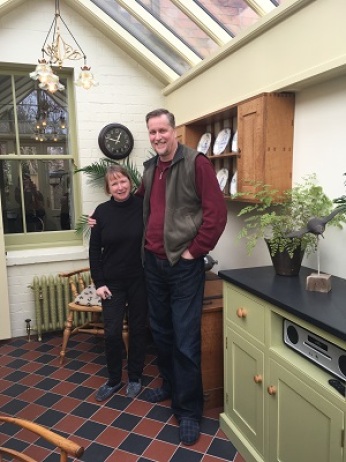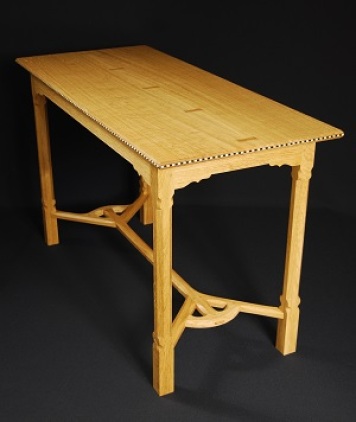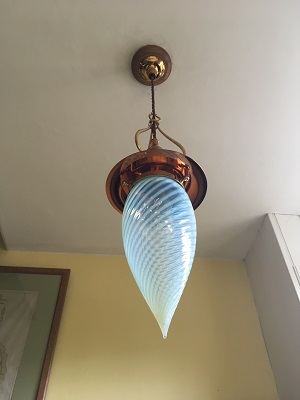
Vickers’ reproduction of the Voysey Kelmscott “Chaucer” cabinet was a commission
Do you really need that 2400-square foot workshop?
I’ve lost track of how many retired friends of friends are currently building themselves shops. Most of these people moved to a rural location so they’d have the space to build. Once you’ve taken the plunge, it seems, the old English saying applies: “In for a penny, in for a Pound.” I mean, why have a shop that will hold a Mini Cooper when you can have one large enough to house a fleet of RVs? Who can’t use the extra space?
As someone who never seems to have enough room to store lumber and salvaged hardware for bona fide jobs, never mind the recycled plant pots, bags of ice-melting salt, antique chamber pots, old dog beds (which, perversely, became “insufferable” [to the dog] after being washed), and surplus hickory floorboards that “just might come in handy, and besides, the wood is so beautiful” (even though the boards in question have been lying there, undisturbed, for a dozen years), I feel your pain. And I am here to share a sobering example of a consummate craftsman who has made a name for himself with a workshop about as big one of those structures we Americans know today as a “tiny home.”
***
Christopher Vickers was born in Bexleyheath, south-east London, in 1961. His father, a cinema sales rep, had a keen interest in all things DIY but was especially taken with marquetry. That love of fine woodworking spread to Chris, who, at the age of 16, decided he wanted to be a furniture maker. No apprenticeship was forthcoming, however, so he served a seven-year apprenticeship as a joiner at Clark and Son in Islington.

Chris and Jenny Vickers in the conservatory they added onto their house
It was an excellent foundation in woodcraft: He made windows, doors, and staircases according to traditional methods. Still, he longed for finer work. When a friend suggested he apply to the London College of Furniture, he did. Most applicants to the program had taken A-Level exams (roughly equivalent to graduating from a high school in the United States), the usual prerequisite for university admission. But Chris’s significant woodworking experience, combined with his passionate desire to refine his skills, won him admission.
During that two-year furniture training Chris and his classmates visited the Cheltenham Museum (now called The Wilson) in Gloucestershire to see some of Alan Peters’ work. The museum also had extensive holdings of work by many other luminaries of the Arts and Crafts Movement, among them Ashbee, Gimson, Voysey, and the Barnsleys. “When I saw all the exposed joinery of the Cotswolds School, the penny dropped,” he remembers. He knew the direction in which he wanted to take his own work.

A Vickers reproduction of one of Ernest Gimson’s hayrake tables
After college he spent two years working part-time for a specialist silverware canteen maker, F. Mottram, in London, making pieces for Asprey’s and other top silversmiths. He then set out on his own, producing jewelry, sewing, and writing boxes made from English hardwoods.
In October 1987 Chris and his wife, Jenny, moved to the small town of Frome in Somerset, primarily because it was affordable. They bought a Victorian red brick row house on a narrow lot typical of that architectural form, and Chris set up a woodworking shop measuring 18’ by 8’ (yes, that’s under 150 square feet), which he nicknamed “the bunker,” in the backyard.

Vickers in his workshop with one of his canteens
The ceiling height tapers from 8’ at the high end down to 6’. Chris is 6’ 2-1/2” tall.
With a workbench, hand tools, and basic set of small machines, he turned out beautifully crafted boxes that he sold at craft fairs, supporting himself and Jenny on that income. Small boxes were made with keyed miters, larger ones with handcut dovetails. His interest in specialty hardware for the boxes eventually led him to begin fabricating his own hinges, straps, and latches. He started making furniture for their home, along with small pieces such as side tables and chairs to sell.
His big break came in 1998. The owner of the Hotel Pattee in Perry, Iowa, wanted to create a room decorated in authentic William Morris style. On a trip to England she visited the Cheltenham Museum, where she met Arts and Crafts expert and curator Mary Greensted. Mary suggested she contact Chris. What began with an invitation to lunch at their home turned into two years of steady work.
“We had never flown before,” Chris remembers, “and the client flew us over business class, which was an adventure in itself.” Chris and Jenny were in Iowa for about two weeks, “wined and dined and shown around.” When the furniture was finished, it was shipped to its destination. “All done with just a handshake!” he adds. The hotel’s website has a section on the Morris Room with photos of Chris’s work.
After the hotel commission Chris was confident of his ability to make larger pieces in his tiny workshop. “The rule of thumb thereafter was, once I had worked out the size of the piece, would it go up the hall [of our house] and out the front door? Assuming the answer was yes, then I just needed to work out how to assemble and finish the main parts in our living room.”
Did you get that? He made the parts in his workshop, then assembled the pieces in their living room.
(OK, OK. Maybe there are advantages to having a shop with more than 150 square feet.)
This concern with size should help explain why he now specializes in lighting, which was originally an offshoot of his work producing his own hardware. In 2014 he added a second workshop to the backyard (this one 12’ long by 6’ wide with slightly higher headroom than “the bunker”), where he crafts replicas of original fixtures designed by W.A.S. Benson, C.F.A. Voysey, and the Birmingham Guild of Handicrafts.

“The bunker” at left. New workshop for lighting and metalwork in the far ground.

One of the many light fixtures Vickers now makes
You can see more of Chris’s work and read more about him at Inspired Illuminations
–Nancy Hiller, author of Making Things Work